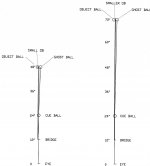Why don't you go educate yourself on my feelings about Marty Herman. LOL
Look up post #29.
http://forums.azbilliards.com/showthread.php?t=265987&page=2
you do moderate in the live stream correct?
Why don't you go educate yourself on my feelings about Marty Herman. LOL
Look up post #29.
http://forums.azbilliards.com/showthread.php?t=265987&page=2
you do moderate in the live stream correct?
i will ask for about the fifth time...do you moderate in those live streams? Y/N
i asked a simple yes or no question that you dragged us into nearly to 10 post between us?
LAMas,
Interesting diagrams. Thank you for posting them.
IMO, none of the standard versions of CTE use pre-pivot alignments like you are suggesting. Also, it appears to me that the scale of your diagrams is very exaggerated/distorted, especially the perspective effect at the small CB-OB distances illustrated. The bridge (pivot) length is also extremely short in your diagrams. Do you think this approach would still work with a more realistic scaling for perspective? Also, do you think it would work for a wide range of CB-OB distances (i.e., would the resulting OB cut angle be the same for all CB distances)? Also, could a fixed and comfortable bridge length then be used for all shots?
Are you proposing a modification to Stan's version on CTE (with an OB-perspective-dimension pre-pivot shift parallel to the CTE line, instead of Stan's one-tip off-center placement)? Are you also suggesting Stan's bridge length changes would no longer be required? If you are proposing a modified version of CTE, could you explain how the procedure would be different from Stan's version? If your approach creates a practical and useful improvement to Stan's method, I would be happy to add it to my CTE resource page (with credit to you, and with a link back to the AZB post where you eventually explain the procedure modifications).
Thanks again for you time and effort.
Regards,
Dave

If your approach creates a practical and useful improvement to Stan's method,
Regards,
Dave
im not a bright guy lamas and i know you don't use cte/pro1, not sure why dr dave brought up all those cte/pro1 comments. Now can you explain exactly what you are showing in these pictures, so a not so bright guy like myself can understand exactly what your thinking?
"Apparently, you are dense.
--------------------------------------------------------------------------------
SUPERSTAR "
Just kidding.:smile:
lol so i have herd
You are a herd animal? You are in good company.:smile:
Can it be? Could it be? The voice of reason again? Welcome back, Sir!
Jim
im not a bright guy lamas and i know you don't use cte/pro1, not sure why dr dave brought up all those cte/pro1 comments. Now can you explain exactly what you are showing in these pictures, so a not so bright guy like myself can understand exactly what your thinking?
i am serious about trying to understand your pictures and what they mean, i have nothing against you, you have always been a respectful honest guy on here i think anyways. Now i will try and figure out what your saying :thumbup:
his site reminds me of my bedroom when i was like 13
You are not alone for there have been 2,209 hits on this thread so far.:smile:
I hope that your bedroom was as cluttered with girls instead of pool info.:thumbup: